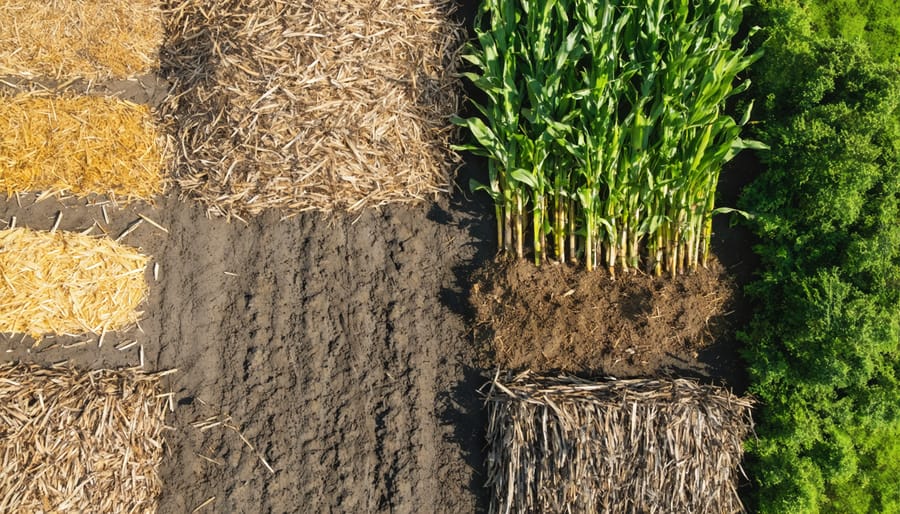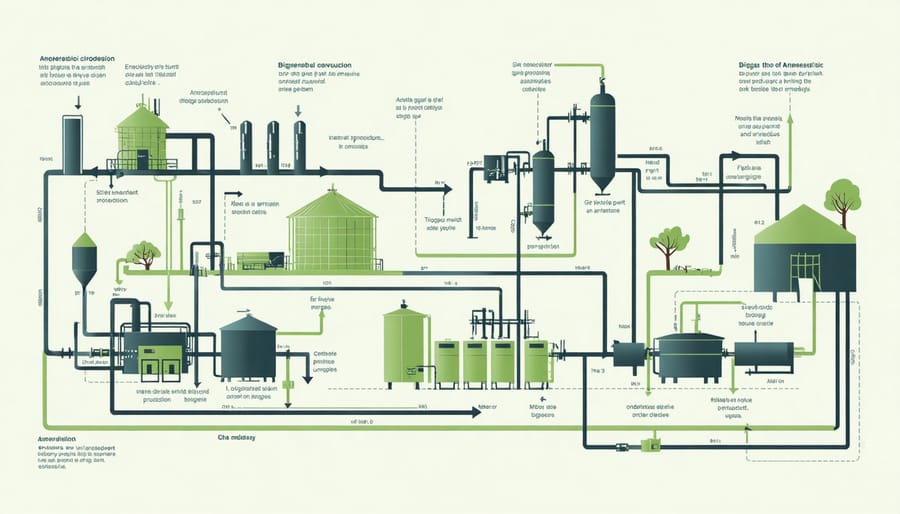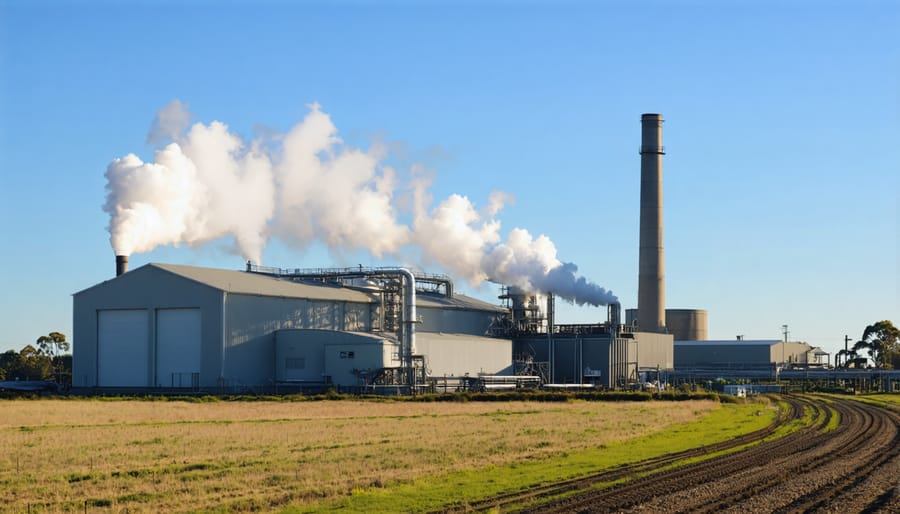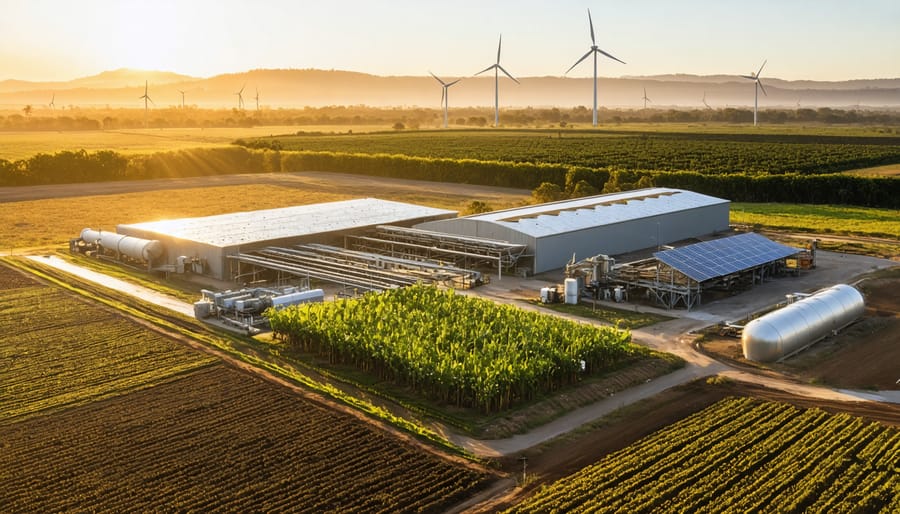In the sun-drenched landscape of Australian agriculture, bioconversion technologies are revolutionizing how we transform organic waste into valuable resources. From sprawling cattle stations in Queensland to boutique vineyards in South Australia’s wine country, these innovative systems are turning agricultural by-products into energy, fertilizers, and sustainable materials.
Imagine converting your farm’s organic waste into clean energy that powers your entire operation, or transforming food processing residues into premium soil amendments. This isn’t future technology – it’s happening right now across Australia, where forward-thinking farmers and agribusinesses are already harnessing the power of bioconversion to slash operational costs and reduce their environmental footprint.
At its core, bioconversion is nature’s own recycling system, supercharged by modern technology. Through precisely controlled biological processes, these systems efficiently convert organic materials into valuable products, creating new revenue streams while addressing waste management challenges. From anaerobic digestion that produces biogas to innovative insect farming systems that transform organic waste into protein-rich feed, Australian agriculture is entering a new era of sustainable resource management.
As global markets increasingly demand sustainable practices, bioconversion technologies offer Australian producers a competitive edge while contributing to our national climate goals. The transformation is already underway – and it’s reshaping the future of Australian agriculture.
The Power of Agricultural Waste: Australia’s Untapped Energy Source
From Field to Fuel: Common Biomass Sources
Australia’s abundant biomass resources in Australia offer diverse opportunities for sustainable energy production. Agricultural residues, including sugar cane bagasse, wheat straw, and corn stalks, represent a significant portion of available biomass, particularly in Queensland and New South Wales farming regions.
In our bushland areas, forest residues for energy production provide another valuable source, incorporating materials like wood chips, bark, and sawdust from sustainable forestry operations. These materials, previously considered waste, now serve as valuable renewable energy resources.
Urban and industrial organic waste streams complete the biomass trifecta. Food waste from restaurants and households, green waste from council collections, and organic manufacturing by-products all present opportunities for bioconversion. Many local councils are already transforming these materials into biogas and compost, demonstrating the practical potential of waste-to-energy systems.
The beauty of these biomass sources lies in their regenerative nature and widespread availability across the country, making them ideal candidates for local energy production initiatives.

Regional Biomass Hotspots
Australia’s agricultural landscape offers incredible potential for biomass production, with several regions emerging as powerhouse locations for bioconversion opportunities. The wheat belt stretching across Western Australia, South Australia, and New South Wales generates substantial crop residues that can be converted into valuable bioenergy resources. These areas produce millions of tonnes of agricultural waste annually, making them prime candidates for bioconversion facilities.
Queensland’s sugarcane region stands out as another significant biomass hotspot, where bagasse – the fibrous remnants of sugar production – already powers local mills and could be further utilised for advanced biofuel production. The tropical north, particularly around the Atherton Tablelands, presents unique opportunities with its year-round growing conditions and diverse crop varieties.
Victoria’s Goulburn Valley, known for its fruit orchards and dairy farms, offers excellent potential for converting food processing waste and animal manure into biogas. Meanwhile, Tasmania’s forestry sector provides a steady stream of woody biomass that could support various bioconversion projects.
These regions not only possess abundant biomass resources but also benefit from existing agricultural infrastructure and established transport networks, making them ideal locations for scaling up bioconversion technologies.
Modern Bioconversion Technologies at Work

Anaerobic Digestion Systems
Anaerobic digestion systems are proving to be game-changers in Australia’s sustainable energy revolution, particularly on farms where organic waste management meets renewable energy production. These systems work by breaking down organic matter in an oxygen-free environment, producing biogas and nutrient-rich digestate.
On Australian dairy farms, the process typically begins with collecting manure and food waste in a sealed digester tank. Naturally occurring bacteria then break down this material over 20-40 days, producing methane-rich biogas that can be used for electricity generation or heating. The remaining digestate serves as an excellent fertiliser, creating a circular economy on the farm.
The benefits are substantial and multifaceted. Farmers report up to 60% reduction in electricity costs, while significantly reducing greenhouse gas emissions from waste management. For instance, the Dobson family farm in Victoria generates enough power from their digester to run their entire dairy operation and sell excess electricity back to the grid.
Real-world applications are growing across the country. In Queensland, several piggeries have installed digesters that power their operations while reducing odour issues. The technology has proven particularly successful in areas where grid connection is expensive or unreliable, offering farmers energy independence and resilience against power outages.
Gasification Technology
Gasification represents a groundbreaking approach to converting organic waste into valuable gases, offering a sustainable solution for Australia’s energy needs. This process transforms biomass materials like agricultural residues, wood waste, and even municipal green waste into a versatile synthesis gas, commonly known as syngas.
In this process, biomass is heated in a controlled environment with limited oxygen, typically at temperatures between 700-1000°C. The resulting syngas is primarily composed of hydrogen and carbon monoxide, which can be used directly for heating or power generation, or further processed into various biofuels and chemicals.
Australian farmers and industrial facilities are increasingly adopting gasification technology to manage waste while generating clean energy. For instance, a sugar mill in Queensland successfully implemented a gasification system that converts bagasse (sugar cane residue) into power for their operations, significantly reducing their reliance on grid electricity.
The flexibility of gasification technology makes it particularly attractive for remote Australian communities. These systems can be scaled to suit different needs, from small farm operations to large industrial facilities. The produced syngas can power generators, heat buildings, or fuel industrial processes, providing a reliable and sustainable energy source.
Recent technological advances have improved the efficiency and reliability of gasification systems, making them more accessible and economically viable for Australian businesses looking to reduce their carbon footprint while managing organic waste effectively.
Direct Combustion Solutions
Direct combustion remains one of the most straightforward and widely-used bioconversion technologies in Australia, combining traditional wisdom with modern innovations. From the humble wood-fired stove to sophisticated industrial biomass furnaces, this method has evolved significantly while maintaining its core simplicity.
In rural Australia, many farmers and agricultural businesses have embraced advanced combustion systems that efficiently convert agricultural waste into heat and power. These modern systems feature automated feed mechanisms, precise temperature controls, and enhanced emission reduction technologies, making them far more efficient than their predecessors.
A standout example is the Berrybank Farm in Victoria, which utilises a state-of-the-art biomass combustion system to process agricultural residues. The system not only provides heat for the farm’s operations but also generates electricity for the local grid, demonstrating the versatility of direct combustion solutions.
Recent innovations in combustion technology have introduced fluidised bed systems, which achieve higher efficiency rates and lower emissions by suspending fuel particles in an upward-flowing air stream during combustion. These systems are particularly effective for processing varied biomass feedstocks common in Australian agriculture, such as bagasse from sugar cane processing and wood waste from forestry operations.
Importantly, modern direct combustion installations incorporate sophisticated air quality control systems, ensuring that emissions meet or exceed environmental standards while maximising energy output. This balance of efficiency and environmental responsibility makes direct combustion an increasingly attractive option for Australian businesses seeking sustainable energy solutions.
Success Stories: Australian Farms Leading the Change

Queensland Sugar Mill Revolution
In a remarkable display of agricultural innovation, Queensland’s sugar mills have revolutionized their operations by transforming waste products into valuable renewable energy. The shift began in the early 2000s when several mills recognized the untapped potential in bagasse, the fibrous residue left after sugarcane crushing.
Leading this transformation was the Mackay Sugar cooperative, which implemented a groundbreaking bioconversion system that processes over 300,000 tonnes of bagasse annually. This initiative not only powers the mill’s operations but also exports surplus electricity to the local grid, providing clean energy for thousands of homes in the region.
The success story expanded as other mills followed suit. The Rocky Point Sugar Mill near the Gold Coast developed an innovative two-stage combustion process that maximizes energy extraction from bagasse while minimizing emissions. This system achieves an impressive 85% efficiency rate in converting waste to energy.
What makes the Queensland sugar mill revolution particularly notable is its circular economy approach. The process utilizes waste that would otherwise be discarded, reduces operational costs, and creates additional revenue streams through power generation. Most importantly, it significantly decreases the industry’s carbon footprint.
This transformation has positioned Queensland’s sugar industry as a global leader in sustainable agricultural practices, proving that traditional industries can adapt and thrive in an environmentally conscious world. The model has since inspired similar initiatives across Australia’s agricultural sector.
Victorian Dairy Farm Innovation
In the heart of Victoria’s dairy region, the Maffra Cheese Company has transformed its waste management challenges into a renewable energy triumph. This innovative dairy operation implemented a state-of-the-art biodigester system in 2019, converting waste whey and manure into valuable biogas and fertilizer.
The system processes approximately 50,000 litres of dairy waste daily, generating enough electricity to power not only the entire cheese factory but also contributing excess energy to the local grid. This successful bioconversion project has reduced the facility’s carbon footprint by 80% while solving the persistent issue of waste disposal.
What makes this case particularly impressive is the closed-loop approach. The nutrient-rich digestate, a byproduct of the bioconversion process, is used to fertilize local pastures, creating a sustainable cycle that benefits both the dairy operation and surrounding farmland. The project has saved the company over $300,000 annually in electricity costs and waste management fees.
The Maffra success story has become a blueprint for other Australian dairy farms, demonstrating how bioconversion can transform agricultural waste from a liability into an asset. Local farmers regularly visit the facility to learn about the technology and its implementation, while government agencies point to it as a prime example of sustainable farming practices in action.
Making the Switch: Practical Steps for Farmers
Getting Started with Bioconversion
Getting started with bioconversion doesn’t have to be daunting. The key is to begin with a clear assessment of your available organic resources and desired outcomes. For farmers and businesses in Australia, the first step typically involves conducting a biomass audit to identify potential feedstock sources, whether that’s agricultural waste, food scraps, or animal manure.
Once you’ve identified your resources, consider starting small with a pilot project. Many successful Australian bioconversion operations began with modest systems that were scaled up over time. For example, a dairy farm in Victoria started with a simple digester processing cow manure before expanding to a full-scale operation that now powers their entire facility.
Essential considerations include:
– Available space for processing equipment
– Proximity to feedstock sources
– Local regulations and permits
– Initial investment capacity
– End-product market opportunities
It’s worth connecting with local agricultural extension services or renewable energy consultants who can provide guidance specific to your region. Many state governments offer support programs and grants for businesses transitioning to sustainable practices. Remember, successful bioconversion implementation is about matching the right technology to your specific needs and resources while maintaining a practical, step-by-step approach to growth.
Available Support and Resources
Australia offers robust support for organizations and individuals looking to adopt bioconversion technologies. The Clean Energy Finance Corporation (CEFC) provides significant funding opportunities, with dedicated programs offering loans and grants for bioenergy projects. These initiatives can cover up to 50% of project costs, making the transition to bioconversion more financially accessible.
State governments also contribute through renewable energy schemes. For instance, Victoria’s Renewable Energy Action Plan includes specific allocations for bioconversion projects, while Queensland’s Biofutures Acceleration Program offers matched funding and technical expertise.
Technical assistance is readily available through organizations like Bioenergy Australia and CSIRO, which provide consultation services, feasibility studies, and connection to industry experts. The Australian Renewable Energy Agency (ARENA) maintains a knowledge-sharing platform where businesses can access case studies, best practices, and technical documentation.
Local councils often provide additional support through sustainability officers who can guide businesses through planning approvals and connect them with relevant funding sources. Regular workshops, networking events, and industry forums create opportunities for knowledge exchange and partnership development.
The future of bioconversion technologies in Australia holds tremendous promise for our agricultural sector and environmental sustainability goals. As we face increasing pressure to reduce carbon emissions and find alternative energy sources, these innovative solutions offer a clear path forward for Australian farmers and communities.
The success stories we’ve seen across the country, from dairy farms in Victoria to sugar cane operations in Queensland, demonstrate that bioconversion is not just a theoretical concept but a practical reality with tangible benefits. These pioneering farmers are already reaping the rewards of reduced energy costs, additional revenue streams, and improved waste management practices.
Now is the time for more Australian farmers to embrace this transformative technology. By converting agricultural waste into valuable resources, we can create a more resilient and sustainable farming sector while contributing to our nation’s renewable energy targets. The technology is proven, the support systems are in place, and the benefits are clear.
To get started, farmers should connect with local agricultural extension services, explore available government grants, and engage with successful bioconversion operators in their region. Industry associations and renewable energy groups are ready to provide guidance and support throughout the implementation process.
Together, we can turn our agricultural waste into an opportunity for growth, sustainability, and prosperity. The future of Australian farming isn’t just about producing food and fibre – it’s about leading the way in sustainable energy production through bioconversion technologies.

